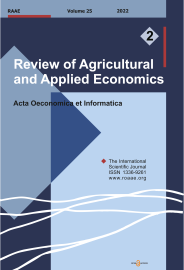KEYWORDS:
biofortification; Two-limit Tobit; maize; willingness-to-pay
DOI NUMBER:
/10.15414/raae.2022.25.02.43-54
ABSTRACT:
Research background: Biofortified maize are products of modern biotechnology and genetic engineering, which produce crops with special traits of interest resistance to pests and diseases, tolerance to the herbicide, high yield, salt tolerance, submergence, nitrogen efficiency, etc. It is not just about technological advances and the development of a new product, ascertaining the factors that could stimulate demand, and creating awareness about the benefits of biofortified crops are crucial for this new enhanced variety of maize to make an impact.Purpose of the article: The research was conducted to determine the factors influencing farmers’ willingness-to-pay for biofortified maize in Gwagwalada Area Council, of the Federal Capital Territory (FCT), Nigeria, to identify the stimulating factors and challenges confronting farmers' willingness-to-pay for biofortified maize.
Methods: The multistage sampling technique was adopted for the study and used to select a total of 100 maize farmers for this study. Primary data were collected from the respondents using a well-structured questionnaire. The data were analyzed using descriptive statistics and the Two-limit Tobit Model, which was used to identify the factors influencing farmers' willingness-to pay for biofortified maize.
Findings, value-added & novelty: The study found that the majority of the maize farmers in FCT, Nigeria were willing-to-pay for biofortified maize, while the result from the Two-limit Tobit analysis revealed that sex, extension contact, access to land, the number of literate in the farmers’ households, and maize farming training were the factors that influenced the maize farmers’ willingness-to-pay for biofortified maize, while non-availability of credit facilities was a major constraint militating against their willingness to pay for biofortified maize. The study recommends that stakeholders should ensure to make credit facilities more accessible to maize farmers to enhance the adoption of biofortified crops, especially maize, and advocated for regulatory land-use acts that will make maize farmers participate more inland ownership systems that are more secured should be put in place for land tenants to benefit so that they can be able to invest and use sustainable maize production strategies to maximize benefits.
Please Cite this Article as:
Moradeyo Adebanjo OTITOJU, Emeka Solomon FIDELIS, Emmanuel Ogaje ABAH (2022) Factors Influencing Farmers’ Willingness-to-pay For Biofortified Maize In The Federal Capital Territory, Nigeria. Review of Agricultural and Applied Economics. (Number , 2022): 33-42. doi: /10.15414/raae.2022.25.02.43-54
URL for sharing:
https://roaae.org/1336-9261/doi/abs//10.15414/raae.2022.25.02.43-54
FULL TEXT PDF:
▼ direct download link| view online in fullscreen ▲

